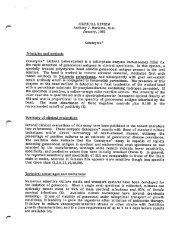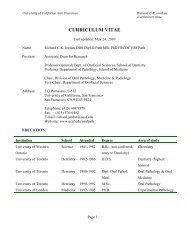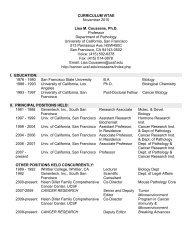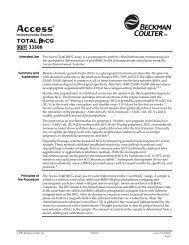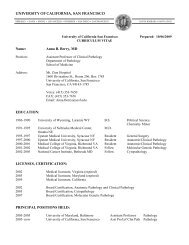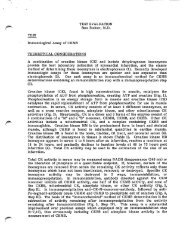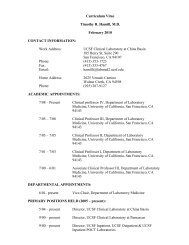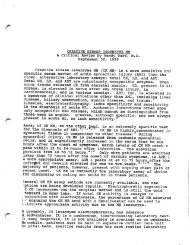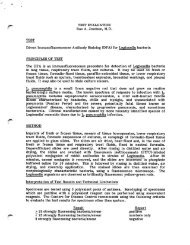Myelodysplastic Syndromes
Myelodysplastic Syndromes
Myelodysplastic Syndromes
You also want an ePaper? Increase the reach of your titles
YUMPU automatically turns print PDFs into web optimized ePapers that Google loves.
<strong>Myelodysplastic</strong> <strong>Syndromes</strong><br />
Joan E. Etzell, MD<br />
Director, Clinical Hematology Lab<br />
UCSF<br />
Current Issues in Anatomic Pathology<br />
May 26, 2011<br />
2008 WHO Classification of Myeloid Neoplasms<br />
Acute<br />
Chronic<br />
Acute Myeloid Leukemia<br />
<strong>Myelodysplastic</strong> <strong>Syndromes</strong><br />
MDS/MPN<br />
Myeloproliferative Neoplasms<br />
Myeloid or lymphoid<br />
neoplasms associated with<br />
eosinophilia and<br />
abnormalities of PDGFRA,<br />
PDGFRB, or FGFR1<br />
Refractory cytopenia with<br />
unilineage dysplasia (RCUD)<br />
Refractory anemia with<br />
ring sideroblasts (RARS)<br />
Refractory cytopenia with<br />
multilineage dysplasia (RCMD)<br />
Refractory anemia with<br />
excess blasts (RAEB)<br />
<strong>Myelodysplastic</strong> syndrome with<br />
Isolated del(5q)<br />
<strong>Myelodysplastic</strong> syndrome,<br />
unclassified<br />
Refractory cytopenia of childhood<br />
Chronic Myelomonocytic Leukemia<br />
Atypical Chronic Myeloid Leukemia,<br />
BCR-ABL1-negative<br />
Juvenile Myelomonocytic Leukemia<br />
MDS/MPN, unclassifiable<br />
Refractory anemia with ring<br />
sideroblasts associated with<br />
marked thrombocytosis<br />
Lecture Outline<br />
• MDS and Classification<br />
• Morphologic dysplasia<br />
• Reactive conditions with dysplasia<br />
• Cytogenetics/FISH<br />
• Flow Cytometry<br />
• Hypocellular MDS<br />
<strong>Myelodysplastic</strong> Syndrome<br />
• Clonal hematopoietic stem cell disorders<br />
characterized by:<br />
– Ineffective hematopoiesis<br />
– Peripheral blood cytopenia(s)*<br />
• Hemoglobin < 10 g/dL<br />
• Absolute neutrophil count < 1.8 x10 9 /L<br />
• Platelets < 100 x10 9 /L<br />
– Dysplasia in one or more myeloid lineages<br />
– Increased risk of acute myeloid leukemia<br />
*Values above these levels are not exclusionary for a diagnosis of MDS<br />
if definitive dysplasia and/or cytogenetic findings are present.<br />
1
<strong>Myelodysplastic</strong> Syndrome<br />
• Incidence of 3-5/100,000 with male<br />
predominance<br />
• Occurs primarily in older adults with<br />
median age of ~70 years<br />
• ~10,000 new MDS cases diagnosed<br />
annually in the United States<br />
• Many of us encounter bone marrow<br />
evaluations to “rule out” MDS in cytopenic<br />
patients! (if only it were that easy….)<br />
MDS Challenges<br />
• Dysplasia is required for diagnosis but is<br />
not specific…..<br />
– Requires careful correlation with clinical<br />
information to exclude non-neoplastic causes:<br />
• Medications/chemotherapy • Toxin exposure<br />
• Nutritional status • Cytokine therapy (G-CSF)<br />
• Infections, including HIV • Congenital conditions<br />
• Autoimmune conditions<br />
– If unilineage dysplasia and absence of a<br />
clonal cytogenetic abnormality, 6 month<br />
observation is recommended by WHO before<br />
a definitive diagnosis of MDS<br />
<strong>Myelodysplastic</strong> Syndrome<br />
• Diagnostic features:<br />
– Morphologic dysplasia : at least 10% of cells in<br />
one or more lineages, ring sideroblasts<br />
– Clonal cytogenetic abnormality (50% of cases)<br />
• can be used as presumptive evidence of MDS if<br />
dysplasia lacking<br />
– Increased blasts (if not on G-CSF)<br />
• Other causes of dysplasia should be excluded<br />
(especially if a cytogenetic abnormality is lacking)<br />
MDS Challenges<br />
• MDS may lack sufficient morphologic<br />
dysplasia to allow definitive diagnosis<br />
– Defined cytogenetic abnormalities provide<br />
presumptive evidence of MDS; patients should be<br />
monitored for emerging morphologic evidence of MDS<br />
– Some lack dysplasia and cytogenetic abnormality at<br />
initial presentation; continued monitoring and repeat<br />
evaluation may be required<br />
• “idiopathic cytopenia of undetermined significance”<br />
(does not meet minimal criteria for MDS by WHO)<br />
• Cytogenetic abnormalities seen in other<br />
disorders (e.g. aplastic anemia)<br />
2
WHO MDS Classification<br />
• Dysplasia without increased blasts*:<br />
− Refractory cytopenia with unilineage dysplasia (RCUD)<br />
Refractory anemia, neutropenia, or thrombocytopenia<br />
– Refractory anemia with ring sideroblasts* (RARS)<br />
– Refractory cytopenia with multilineage* dysplasia (RCMD)<br />
• Increased blasts:<br />
– RAEB-1 (2-4% blood; 5-9% marrow)<br />
– RAEB-2 (>5% blood; 10-19% marrow; Auer rods)<br />
*Dysplasia must be present in > 10% of cells within a lineage (erythroid,<br />
granulocytic, megakaryocytic); “multilineage” dysplasia is at least 2 lineages<br />
Without increased blasts:
WHO MDS Classification<br />
MDS, unclassified<br />
3 situations for MDS-U:<br />
• RCUD or RCMD but with 1% peripheral<br />
blasts<br />
• Unilineage dysplasia with pancytopenia<br />
• Cytopenia(s),
Neutrophil dysplasia<br />
• Hypo-, agranularity<br />
• Nuclear hypolobation<br />
(pseudo Pelger-Huet)<br />
• Irregular<br />
hypersegmentation<br />
• Pseudo Chediak-Higashi<br />
granules<br />
• Megaloblastic maturation<br />
• Small or large size<br />
• Auer rods (neoplastic!)<br />
Megakaryocytic dysplasia<br />
• Micromegakaryocytes<br />
• Nuclear hypolobation<br />
• Multinucleation (normal<br />
megs are uninuclear with<br />
lobation)<br />
5
The patient is 62<br />
year old man who<br />
presents with<br />
increasing fatigue<br />
and bruising over<br />
several months.<br />
The patient is on no<br />
medications.<br />
CBC analysis<br />
shows:<br />
WBC 2.7 x10 9 /L;<br />
Neuts 1.1 x10 9 /L<br />
HGB 9.1 g/dL<br />
MCV 96 fl<br />
PLTS 47x10E9/L<br />
Cytogenetics: Normal<br />
Ring sideroblasts:<br />
− MDS<br />
− Alcohol/toxins<br />
− Drugs (e.g. INH)<br />
− Zinc toxicity<br />
− Copper deficiency<br />
− Pyridoxine deficiency<br />
− Congenital<br />
sideroblastic anemia<br />
− Mitochondrial cytopathy<br />
(Pearson syndrome)<br />
In this case, features<br />
suggest copper deficiency<br />
(in some cases due to zinc<br />
toxicity)<br />
RARS<br />
9 year old girl presenting with fever and pancytopenia<br />
Hemophagocytic lymphohistiocytosis (HLH); dysplasia may be cytokine related<br />
6
MDS<br />
cytogenetics<br />
Presumptive diagnosis in<br />
patients with persistent<br />
cytopenias of undetermined<br />
origin but lacking diagnostic<br />
morphologic dysplasia<br />
(should be followed for definitive<br />
dysplasia before unequivocal dx)<br />
*Alone NOT considered<br />
definitive evidence for MDS<br />
(in absence of dysplasia):<br />
+8<br />
del(20q)<br />
Abnormality Frequency (diagnosis)<br />
Unbalanced<br />
-7 or del(7q) 10% (50% t-MDS)<br />
-5 or del(5q) 10% (40% t-MDS)<br />
+8* 10%<br />
del(20q)* 5-8%<br />
-Y* 5%<br />
i(17q) or t(17p) 3-5%<br />
del(11q) 3%<br />
del(12p) or t(12p) 3%<br />
-13 or del(13q) 3%<br />
del(9q) 1-2%<br />
idic(X)(q13) 1-2%<br />
Balanced<br />
t(11;16)(q23;p13.3) (3% t-MDS)<br />
t(3;21)(q26.2;q22.1) (2% t-MDS)<br />
t(1;3)(p36.3;q21.2) 1%<br />
t(2;11)(p21;q23) 1%<br />
inv(3)(q21;q26.2) 1%<br />
t(6;9)(p23;q34) 1%<br />
-Y WHO Classification of Tumours of Haematopoietic and Lymphoid<br />
Tissues, 2008.<br />
Flow Cytometry in MDS<br />
• Presently not routinely used for diagnosis or<br />
classification<br />
• Evaluation of previously diagnosed MDS by highly<br />
experienced flow labs with numerous myeloid<br />
markers and objective criteria for “abnormal” show:<br />
• Sensitivity: ~70-90%<br />
• Specificity: ~90%<br />
• ~10% flow abnormal with non-diagnostic<br />
morphology and cytogenetics<br />
– Insufficient data to determine whether these<br />
biologically behave like MDS (true or false pos?)<br />
FISH Analysis<br />
• Panels often include -5/del(5q), -7/del(7q), +8,<br />
and del(20q)<br />
• FISH correlates with karyotypic findings<br />
• FISH detects few (0-6%) additional abnormalities<br />
if karyotype is adequate and generally not needed<br />
in this setting<br />
• FISH useful if:<br />
– suboptimal metaphase analysis; detects up to 15%<br />
more abnormalities<br />
– morphology suggests a specific abnormality that was<br />
not detected by cytogenetics<br />
• Sensitivity for residual disease following treatment<br />
is not much better than routine karyotype<br />
Flow Cytometry in MDS<br />
Cautions<br />
• Reactive conditions (marrow recovery, G-CSF<br />
therapy, infection) can cause mild phenotypic<br />
alterations.<br />
• Insufficient literature to fully understand myeloid<br />
phenotypic change in reactive conditions that may<br />
mimic MDS<br />
• Blast assessment can be useful, but...morphologic<br />
blast count required for diagnosis and<br />
classification because:<br />
– Some blasts do not express stem cell antigens (CD34, CD117)<br />
– Processing for flow lyses erythroid precursors<br />
– Blasts can be fragile with a subset lost during processing<br />
7
8% blasts (CD34, CD117)<br />
75% monocytic cells<br />
Remember: promonocytes are blast equivalents<br />
WHO Classification-Based Prognostic<br />
Scoring System for MDS<br />
Prognostic Variable Score Value<br />
*Karyotype definitions same as IPSS<br />
*RBC transfusion dependency defined<br />
as at least 1 RBC transfusion every 8<br />
weeks over a period of 4 months.<br />
0 1 2 3<br />
WHO category RA, RARS,5q- RCMD RAEB-1 RAEB-2<br />
Karyotype Good Intermediate Poor<br />
Transfusion* No Regular<br />
Risk groups Score AML<br />
Very low 0 3-6%<br />
Low 1 14-24%<br />
Intermediate 2 33-48%<br />
High 3-4 54-63%<br />
Very high 5-6 84-100%<br />
Median follow up 27-30 months<br />
Malcovati L, et al. Time-Dependent Prognostic Scoring System for Predicting Survival<br />
and Leukemic Evolution in <strong>Myelodysplastic</strong> <strong>Syndromes</strong>. J. Clin. Oncol. 2007, 25: 3503-3510.<br />
International Prognostic Scoring System (IPSS)<br />
Prognostic<br />
variable<br />
Score Value<br />
0 0.5 1.0 1.5 2.0<br />
BM blasts (%) 3 abnormalities) or<br />
abnormalities of chromosome 7<br />
Intermediate : other abnormalities<br />
Cytopenias defined as:<br />
•Hemoglobin
Hypocellular MDS<br />
• Proper classification usually accomplished by:<br />
– Careful exam of blood/aspirate smears for<br />
dysplasia and blasts<br />
– estimation of CD34+ blasts on the biopsy (IHC or<br />
flow cytometry)<br />
– cytogenetics (e.g. abnormality of 5 or 7)<br />
• May be useful: iron stain, reticulin stain, PNH<br />
markers<br />
• Similar to RCUD, if unilineage dysplasia and no<br />
cytogenetic abnormality or increase in blasts, 6<br />
month observation is appropriate<br />
• If you can’t call it– don’t!<br />
Hypocellular MDS<br />
• Differential diagnosis includes:<br />
– Acute myeloid leukemia (AML)<br />
– Hairy cell leukemia<br />
– T-large granular lymphocytic leukemia<br />
– Toxic effects<br />
– Aplastic anemia<br />
– Paroxysmal nocturnal hemoglobinuria (PNH)<br />
• Hypocellular MDS has higher risk of AML than<br />
AA and PNH<br />
9
Acquired Aplastic anemia<br />
• Aplastic anemia (AA)<br />
– Peripheral cytopenias and marrow hypoplasia<br />
(
Paryoxysmal Nocturnal Hemoglobinuria<br />
(PNH)<br />
• Lack of GPI anchor proteins (eg CD55 and<br />
CD59) resulting in hemolysis and other<br />
clinical complications<br />
• Can evolve to marrow failure syndrome with<br />
hypocellularity similar to AA or hypocellular<br />
MDS<br />
• Some postulate PNH is a manifestation of<br />
aplasia/myelodysplasia spectrum since all<br />
can demonstrate PNH-like cells<br />
WHO MDS Classification<br />
Refractory cytopenia with unilineage dysplasia<br />
– Refractory anemia (RA)<br />
– Refractory neutropenia<br />
– Refractory thrombocytopenia<br />
• Requires one (or two) cytopenias and unilineage<br />
dysplasia (in >10% of one lineage); blasts not increased<br />
• Dysplasia may not be overt (can be difficult to<br />
diagnose…)<br />
• Cytogenetic abnormalities in up to 50%<br />
• Median survival ~66 months<br />
<strong>Myelodysplastic</strong> Syndrome<br />
• Diagnostic workup should include:<br />
– Comprehensive history and physical exam<br />
– CBC with differential<br />
– Nutritional studies if indicated (B12, folate, iron)<br />
– Reticulocyte count (if anemia)<br />
– BM aspiration and biopsy<br />
– Iron stain<br />
– Cytogenetics<br />
WHO MDS Classification<br />
Refractory anemia with ring sideroblasts<br />
• Erythroid dysplasia only; blasts not increased (15% ring sideroblasts<br />
− 5 or more granules encircling at least 1/3 of the<br />
nucleus<br />
− Ring sideroblasts can be seen in other categories of<br />
MDS<br />
• Cytogenetic abnormalities in 5-20%<br />
• Median survival ~69-108 months<br />
• Must exclude non-neoplastic causes of ring sideroblasts<br />
(alcohol, toxins, drugs (e.g. INH), zinc, copper<br />
deficiency, and congenital sideroblastic anemia)<br />
11
WHO MDS Classification<br />
• Refractory cytopenia with multilineage<br />
dysplasia<br />
– Dysplasia in >10% of cells in 2 lineages<br />
– Blasts
The patient is a 32<br />
year old taxi driver<br />
who presents with a 4<br />
month history of<br />
increasing fatigue. He<br />
is transferred with a<br />
presumed diagnosis of<br />
MDS or acute<br />
leukemia.<br />
CBC shows:<br />
WBC 3.6 x10 9 /L;<br />
neuts 1.6 x10 9 /L<br />
Hgb 6.1 g/dL<br />
Hct 17.3%<br />
MCV 102 fl<br />
Platelets 190 x10 9 /L<br />
Megaloblastic anemia<br />
(associated with vitamin B12 or folate def)<br />
• peripheral blood smear:<br />
– macro-ovalocytes<br />
– hypersegmented neutrophils<br />
• Bone marrow:<br />
– Megaloblastic change in erythroid, and granulocytic<br />
precursors<br />
– Erythroid hyperplasia and left shift<br />
– Mild dyserythropoiesis<br />
– With or without mild megakaryocytic dysplasia<br />
In this patient reticulocytes and nrbc were seen on the blood smear 4<br />
days following vitamin B12 replacement<br />
13
Acquired Pelger-Huet Anomaly<br />
associated with drugs<br />
• a predominance of uni-lobed neutrophils (with<br />
occasional bi-lobed forms present); in some cases<br />
many band forms may also be seen<br />
• Abnormally coarse nuclear chromatin<br />
• uniformity in appearance of the neutrophil<br />
population<br />
• ABSENCE OF OTHER MORPHOLOGIC<br />
DYSPLASIA<br />
Dyserythropoiesis Dysgranulopoiesis Dysmegakaryopoiesis<br />
Chemotherapy/bone marrow Chemotherapy/bone marrow Chemotherapy/bone marrow<br />
regeneration<br />
regeneration<br />
regeneration<br />
Vitamin B12/folate<br />
Vitamin B12/folate<br />
Vitamin B12/folate deficiency<br />
deficiency, and rarely deficiency, and rarely (some cases)<br />
pyridoxine (B6) deficiency pyridoxine (B6) deficiency<br />
Infections (parvovirus, HIV) Infections (HIV) Infections (HIV)<br />
Autoimmune conditions Autoimmune myelofibrosis<br />
Post-transplant Post-transplant<br />
Medications, alcohol and<br />
other toxins, heavy metals<br />
(e.g. arsenic) etc.<br />
Rapid erythroid proliferation<br />
in response to anemia;<br />
erythropoietin therapy<br />
Aplastic anemia/PNH<br />
Paraneoplastic Paraneoplastic myelofibrosis<br />
Medications (e.g. tacrolimus,<br />
mycophenolate mofitel,<br />
gancyclovir, purine analogs)<br />
Exogenous (G-CSF) or<br />
endogenous (e.g. sepsis)<br />
cytokines<br />
Hemophagocytic<br />
Hemophagocytic<br />
lymphohistiocytosis lymphohistiocytosis<br />
Congenital dyserythropoietic Congenital (e.g. Fanconi<br />
anemias<br />
anemia)<br />
Hemophagocytic<br />
lymphohistiocytosis<br />
Transient abnormal<br />
myelopoiesis of Down<br />
syndrome; other congenital<br />
disorders<br />
Copper Deficiency<br />
• Granulocytes:<br />
−left shifted<br />
−vacuolization of precursors<br />
• Erythroid series:<br />
−Left shifted with mild megaloblastic<br />
changes and terminal<br />
dyserythropoiesis<br />
−vacuolated cytoplasm<br />
−ringed sideroblasts<br />
• Megakaryocytes: usually normal<br />
• Variable marrow cellularity<br />
• Blasts are generally NOT increased.<br />
G-CSF may result in increased blasts and neutrophil dysplasia<br />
14
The patient is a 56<br />
year old man who is 2<br />
years post orthotopic<br />
liver transplant. The<br />
patient is receiving<br />
tacrolimus and<br />
mycophenolate mofetil<br />
for<br />
immunosuppression.<br />
CBC shows:<br />
WBC 2.6 x10 9 /L;<br />
neuts 1.5 x10 9 /L<br />
Hgb 8.9 g/dL<br />
MCV 79 fL<br />
Platelets 170x10 9 /L<br />
Pelger-Huet Neutrophils<br />
• Inherited Pelger-Huet anomaly<br />
• Myeloid neoplasm, such as MDS or AML<br />
• Recent chemotherapy<br />
• Other medications, including<br />
mycophenolate mofetil, tacrolimus,<br />
gancyclovir, and even trimethoprimsulfamethoxazole<br />
• Infection associated (uncommon, but<br />
occurs)<br />
In this case, neutropenia resolved 4 weeks after decreasing<br />
mycophenolate mofetil dose<br />
15





